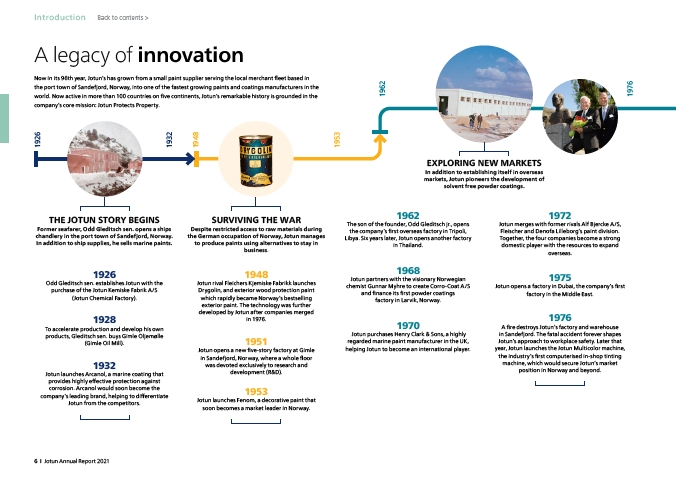
Back to contents >
A legacy of innovation
Now in its 96th year, Jotun’s has grown from a small paint supplier serving the local merchant fleet based in
the port town of Sandefjord, Norway, into one of the fastest growing paints and coatings manufacturers in the
world. Now active in more than 100 countries on five continents, Jotun’s remarkable history is grounded in the
company’s core mission: Jotun Protects Property.
THE JOTUN STORY BEGINS
Former seafarer, Odd Gleditsch sen. opens a ships
chandlery in the port town of Sandefjord, Norway.
In addition to ship supplies, he sells marine paints.
SURVIVING THE WAR
Despite restricted access to raw materials during
the German occupation of Norway, Jotun manages
to produce paints using alternatives to stay in
business.
1926
Odd Gleditsch sen. establishes Jotun with the
purchase of the Jotun Kemiske Fabrik A/S
(Jotun Chemical Factory).
1928
To accelerate production and develop his own
products, Gleditsch sen. buys Gimle Oljemølle
(Gimle Oil Mill).
1932
Jotun launches Arcanol, a marine coating that
provides highly effective protection against
corrosion. Arcanol would soon become the
company’s leading brand, helping to differentiate
Jotun from the competitors.
1948
Jotun rival Fleichers Kjemiske Fabrikk launches
Drygolin, and exterior wood protection paint
which rapidly became Norway’s bestselling
exterior paint. The technology was further
developed by Jotun after companies merged
in 1976.
1951
Jotun opens a new five-story factory at Gimle
in Sandefjord, Norway, where a whole floor
was devoted exclusively to research and
development (R&D).
1953
Jotun launches Fenom, a decorative paint that
soon becomes a market leader in Norway.
EXPLORING NEW MARKETS
In addition to establishing itself in overseas
markets, Jotun pioneers the development of
solvent free powder coatings.
1962
The son of the founder, Odd Gleditsch jr., opens
the company’s first overseas factory in Tripoli,
Libya. Six years later, Jotun opens another factory
in Thailand.
1968
Jotun partners with the visionary Norwegian
chemist Gunnar Myhre to create Corro-Coat A/S
and finance its first powder coatings
factory in Larvik, Norway.
1970
Jotun purchases Henry Clark & Sons, a highly
regarded marine paint manufacturer in the UK,
helping Jotun to become an international player.
1972
Jotun merges with former rivals Alf Bjercke A/S,
Fleischer and Denofa Lilleborg’s paint division.
Together, the four companies become a strong
domestic player with the resources to expand
overseas.
1975
Jotun opens a factory in Dubai, the company’s first
factory in the Middle East.
1976
A fire destroys Jotun’s factory and warehouse
in Sandefjord. The fatal accident forever shapes
Jotun’s approach to workplace safety. Later that
year, Jotun launches the Jotun Multicolor machine,
the industry’s first computerised in-shop tinting
machine, which would secure Jotun’s market
position in Norway and beyond.
1926
1932
1948
1953
1962
1976
Introduction
6 I Jotun Annual Report 2021